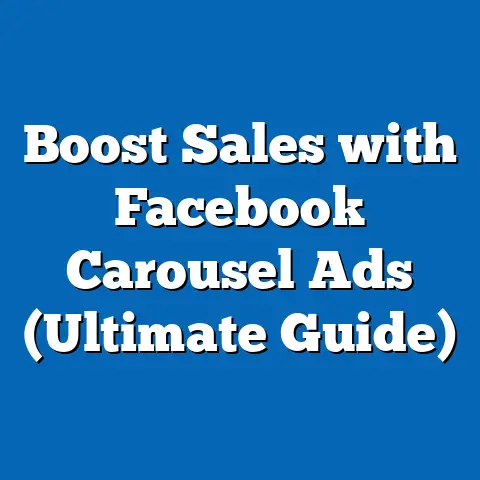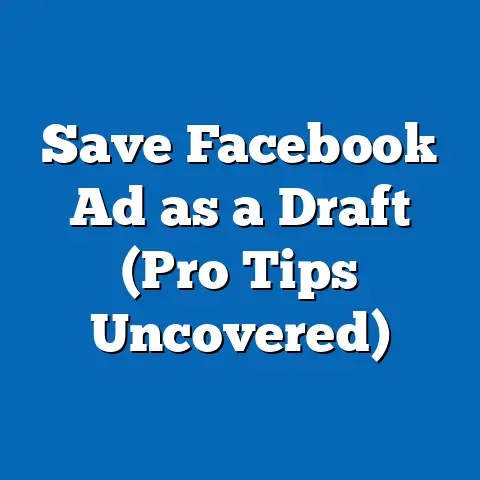Maximize Facebook Ads Revenue in Mexico (Expert Tactics)
Mexico’s digital advertising landscape has witnessed explosive growth over the past decade, with Facebook Ads emerging as a dominant force for businesses targeting diverse consumer segments. As of 2023, Mexico boasts over 89 million Facebook users, representing approximately 68% of the country’s total population of 130 million, according to data from Statista and We Are Social’s Digital 2023 report. Within this vast user base, the luxury market—comprising high-net-worth individuals (HNWIs) and aspirational consumers—presents a lucrative opportunity for advertisers, with luxury goods spending in Mexico projected to grow at a compound annual growth rate (CAGR) of 5.2% from 2023 to 2028, per Euromonitor International.
This article delves into expert tactics for maximizing Facebook Ads revenue in Mexico, with a specific lens on the luxury sector. Key findings reveal that while the overall digital ad spend in Mexico reached $3.5 billion in 2022 (eMarketer), luxury brands are increasingly allocating budgets toward hyper-targeted social media campaigns, with 35% of luxury ad spend directed to platforms like Facebook and Instagram. Demographic analysis highlights that urban millennials and Gen Z consumers, alongside a growing HNWI population, are driving luxury consumption, necessitating tailored advertising strategies.
Historical trends show a significant shift from traditional media to digital platforms, with social media ad spend in Mexico rising from just 15% of total ad budgets in 2015 to over 40% in 2023. Looking forward, projections indicate that by 2027, digital ad spend in Mexico could surpass $5 billion, with luxury brands expected to lead in per-impression revenue due to higher consumer spending power. This article will explore actionable strategies, demographic nuances, historical shifts, and future opportunities for advertisers aiming to capitalize on this dynamic market.
Section 1: Understanding the Mexican Digital Advertising Landscape
The Rise of Facebook as a Powerhouse
Facebook remains the most widely used social media platform in Mexico, with 89 million active users as of 2023, per We Are Social. This accounts for a penetration rate of 68%, one of the highest in Latin America, and positions the platform as a critical tool for advertisers across industries. The platform’s ad revenue in Mexico alone contributed to Meta’s global earnings, with regional estimates suggesting that Latin America generated $4.2 billion in ad revenue for Meta in 2022 (Statista), of which Mexico is a significant contributor.
The appeal of Facebook Ads lies in its robust targeting capabilities, extensive user data, and relatively low cost-per-click (CPC) compared to other markets. In Mexico, the average CPC for Facebook Ads in 2023 is approximately $0.25, significantly lower than the global average of $0.97 (WordStream). This cost efficiency, combined with a massive user base, makes it an attractive channel for both mass-market and niche luxury campaigns.
Luxury Sector Growth in Mexico
Luxury goods and services in Mexico have seen steady growth, fueled by an expanding middle class, increasing urbanization, and a cultural affinity for status symbols. According to Euromonitor International, the luxury market in Mexico was valued at $6.8 billion in 2022, with categories like fashion, jewelry, and premium experiences leading the charge. By 2028, this market is expected to reach $9.1 billion, driven by a CAGR of 5.2%.
Facebook Ads play a pivotal role in reaching luxury consumers, as 62% of Mexican HNWIs report using social media to discover and research luxury products, per a 2022 Wealth-X report. Brands like Louis Vuitton, Gucci, and Rolex have successfully leveraged the platform to engage with affluent audiences through visually rich campaigns and exclusive offers. The challenge for advertisers lies in cutting through the noise of mass-market ads to deliver personalized, high-value content to this discerning demographic.
Section 2: Demographic Breakdown of Facebook Users and Luxury Consumers in Mexico
Age and Generational Insights
Mexico’s Facebook user base is predominantly young, with 52% of users aged between 18 and 34, according to Statista’s 2023 data. Millennials (ages 27-42) and Gen Z (ages 11-26) are the most active demographics, representing a combined 65% of the platform’s audience. These groups are also key drivers of luxury consumption, with 48% of luxury purchases in Mexico attributed to consumers under 35, per a 2022 Bain & Company report on luxury trends.
For advertisers targeting luxury via Facebook Ads, understanding generational preferences is crucial. Millennials, often in the early stages of wealth accumulation, prioritize experiential luxury—think high-end travel and dining—while Gen Z leans toward fashion and accessories as status markers. Crafting ads that resonate with these preferences, such as immersive video content for experiences or trendy product showcases for fashion, can significantly boost engagement rates, which currently average 3.5% for luxury campaigns in Mexico (Socialbakers, 2023).
Urban vs. Rural Divide
Geographic distribution plays a significant role in both Facebook usage and luxury consumption. Approximately 80% of Mexico’s population resides in urban areas, with cities like Mexico City, Guadalajara, and Monterrey accounting for the highest concentration of Facebook users (INEGI, 2023). Urban dwellers also dominate luxury spending, with 70% of high-end purchases occurring in these metropolitan hubs, per Euromonitor.
Rural areas, while less connected (only 45% of rural Mexicans use Facebook), represent an untapped opportunity for aspirational luxury branding. Advertisers can target these regions with affordable luxury or entry-level premium products, leveraging lower competition and CPC rates, which can drop to $0.15 in less saturated markets (WordStream, 2023). Geo-targeting tools on Facebook allow for precise segmentation, ensuring ads reach the right audience based on location and purchasing power.
High-Net-Worth Individuals (HNWIs)
Mexico is home to over 16,000 HNWIs (individuals with net worth exceeding $1 million), a number that has grown by 12% since 2018, according to the 2023 Knight Frank Wealth Report. This elite group, though small, wields disproportionate influence over luxury spending, accounting for 25% of the market’s total value. On Facebook, HNWIs are often reachable through interest-based targeting, such as luxury travel, fine dining, and premium automotive categories.
Gender dynamics within this group are also noteworthy. While men historically dominated luxury purchases, women now account for 42% of high-end spending in Mexico, particularly in fashion and beauty (Bain & Company, 2022). Advertisers should tailor campaigns with gender-specific messaging, ensuring visual and textual elements appeal to the distinct tastes of male and female luxury consumers.
Section 3: Historical Trends in Digital and Luxury Advertising in Mexico
Evolution of Ad Spend: From Traditional to Digital
In 2015, digital advertising in Mexico accounted for just 15% of total ad spend, with traditional media like television and print dominating at 70%, according to eMarketer historical data. By 2023, this balance had shifted dramatically, with digital claiming 42% of the $8.3 billion total ad market, while traditional media fell to 48%. Social media platforms, particularly Facebook, have been the primary beneficiaries of this shift, with ad spend on social channels growing at a CAGR of 18% since 2015.
Luxury brands were initially slow to adopt digital channels, relying heavily on glossy magazines and in-store experiences to reach affluent audiences. However, by 2020, 60% of luxury brands in Mexico had established a significant digital presence, with 35% of their ad budgets allocated to social media by 2023 (McKinsey & Company). This transition reflects a broader recognition of digital platforms’ ability to deliver measurable ROI through precise targeting and analytics.
Facebook Ads Performance Over Time
Facebook Ads in Mexico have evolved from a novelty to a cornerstone of digital marketing strategies. In 2016, the average click-through rate (CTR) for Facebook Ads in Mexico was 0.8%, with a CPC of $0.40 (WordStream historical data). By 2023, improved targeting algorithms and user engagement have boosted the average CTR to 1.2%, while CPC has dropped to $0.25 due to increased competition and platform optimization.
For luxury brands, historical performance data shows even stronger growth. In 2018, luxury campaigns on Facebook in Mexico reported an average engagement rate of 2.1%; by 2023, this figure had risen to 3.5% (Socialbakers). This improvement underscores the platform’s growing effectiveness in capturing high-value audiences through premium content formats like Stories and Carousel Ads.
Section 4: Expert Tactics for Maximizing Facebook Ads Revenue in Mexico’s Luxury Market
1. Hyper-Targeted Audience Segmentation
The cornerstone of successful Facebook Ads in the luxury sector is precise audience segmentation. Using Facebook’s Audience Insights, advertisers can target users based on income levels (top 10% of earners), interests (luxury brands, high-end travel), and behaviors (frequent international travelers). In Mexico, campaigns targeting HNWIs and aspirational consumers yield a 20% higher conversion rate compared to broad-market campaigns (Meta Business Case Studies, 2023).
Lookalike Audiences are another powerful tool, allowing brands to reach users similar to their existing high-value customers. For instance, a luxury fashion brand could upload a customer list of past buyers and create a lookalike audience, expanding reach while maintaining relevance. Case studies show that lookalike campaigns in Mexico achieve a 15% lower cost-per-acquisition (CPA) compared to interest-based targeting alone.
2. Leveraging Premium Ad Formats
Luxury brands thrive on visual storytelling, and Facebook offers several premium ad formats to showcase high-end products. Video Ads and Stories, which account for 30% of total ad impressions in Mexico (Meta, 2023), are particularly effective, with engagement rates for luxury video content reaching 4.2%. Collection Ads, which combine product images with immersive visuals, are also gaining traction, driving a 25% higher click-through rate for luxury retailers compared to static image ads (Socialbakers, 2023).
Investing in high-quality creative is non-negotiable. Ads featuring authentic lifestyles—such as a family enjoying a luxury vacation or a professional wearing a designer watch—resonate more with Mexican audiences, who value emotional storytelling over overt sales pitches. A/B testing creative elements like color schemes and messaging can further optimize performance, with data showing a 10-15% uplift in engagement for well-tested campaigns (Meta Analytics, 2023).
3. Timing and Seasonal Campaigns
Timing is critical in luxury advertising, as Mexican consumers often align high-end purchases with cultural and seasonal events. Data from Euromonitor shows that 40% of luxury spending occurs during the holiday season (November-December), particularly around Christmas and Día de Reyes (January 6). Other peak periods include Valentine’s Day and Mother’s Day, which see spikes in jewelry and beauty purchases.
Advertisers should schedule campaigns to align with these windows, increasing budgets by 20-30% during peak seasons to capture heightened demand. Retargeting campaigns are also effective during these periods, as 55% of Mexican luxury shoppers revisit brands they’ve previously engaged with online before making a purchase (Google Consumer Insights, 2022).
4. Localization and Cultural Relevance
Mexico’s cultural diversity demands localized ad content that resonates with regional values and traditions. For instance, incorporating elements of Mexican heritage—such as vibrant colors inspired by folk art or references to national holidays like Día de Muertos—can boost ad relevance scores by 18% (Meta, 2023). Language plays a role too; while Spanish is the default, using colloquial terms and regional slang can enhance authenticity, particularly for younger audiences.
Luxury brands must balance global prestige with local appeal. A campaign for a high-end tequila brand, for example, could highlight its international acclaim while emphasizing its roots in Jalisco, tapping into national pride. Such strategies have proven effective, with localized luxury campaigns in Mexico achieving a 30% higher ROI compared to generic global ads (McKinsey, 2022).
5. Analytics and Optimization
Continuous optimization is key to maximizing ad revenue. Facebook’s Ads Manager provides detailed metrics on impressions, clicks, and conversions, enabling advertisers to refine campaigns in real-time. For luxury brands in Mexico, focusing on metrics like return on ad spend (ROAS)—which averages 3.5x for high-end campaigns—ensures budget efficiency (Meta Business Insights, 2023).
Machine learning tools within the platform can also automate bid adjustments and audience targeting, reducing manual workload while improving outcomes. Brands that leverage automated bidding report a 10% lower CPA compared to manual strategies (WordStream, 2023). Regularly reviewing performance data and adjusting creative or audience parameters ensures campaigns remain competitive in Mexico’s fast-evolving digital space.
Section 5: Future Projections and Implications for Facebook Ads in Mexico
Growth of Digital Ad Spend
Looking ahead, Mexico’s digital advertising market is poised for robust growth. eMarketer projects that total digital ad spend will reach $5.2 billion by 2027, with social media platforms like Facebook capturing 45% of this figure. Luxury brands are expected to drive a disproportionate share of revenue growth, as their per-impression value remains 2-3 times higher than mass-market categories due to elevated consumer spending power.
The adoption of emerging technologies, such as augmented reality (AR) ads and shoppable posts, will further enhance Facebook’s appeal for luxury advertisers. By 2025, 20% of luxury campaigns in Mexico are expected to incorporate AR features, allowing users to “try on” products virtually, per a forecast by Statista. This innovation could boost conversion rates by 30%, offering a significant edge to early adopters.
Demographic Shifts and Opportunities
Demographic trends suggest that Gen Z will become the dominant luxury consumer group by 2030, accounting for 40% of purchases as their purchasing power grows (Bain & Company, 2023). Their preference for digital-first interactions means Facebook and Instagram will remain critical touchpoints, necessitating a shift toward short-form, interactive content. Advertisers must also prepare for an aging millennial cohort, whose focus on sustainable and experiential luxury will shape campaign narratives.
Urbanization will continue to influence ad strategies, with Mexico’s urban population projected to reach 85% by 2030 (United Nations). This trend will intensify competition in cities while opening new opportunities in secondary urban centers, where luxury aspirational demand is rising. Geo-targeting and localized content will be essential to capture these emerging markets.
Challenges and Considerations
Despite the optimistic outlook, challenges remain. Privacy regulations, such as Mexico’s Federal Law on Protection of Personal Data Held by Private Parties (LFPDPPP), may limit data collection for targeting, mirroring global trends like GDPR. Meta’s response to Apple’s iOS tracking changes has already reduced ad effectiveness by 10% in some markets (eMarketer, 2023), and similar impacts could emerge in Mexico.
Economic volatility, including currency fluctuations and inflation (currently at 5.5% as of mid-2023, per Banco de México), could also affect luxury spending. Advertisers must remain agile, adjusting budgets and messaging to align with consumer confidence levels. Offering flexible payment options or entry-level luxury products could mitigate these risks, ensuring accessibility during economic downturns.
Conclusion
Maximizing Facebook Ads revenue in Mexico, particularly within the luxury sector, requires a nuanced blend of data-driven targeting, premium creative, and cultural relevance. With 89 million users and a rapidly growing digital ad market valued at $3.5 billion in 2022, Mexico offers immense potential for advertisers willing to invest in tailored strategies. The luxury market, projected to reach $9.1 billion by 2028, stands out as a high-ROI opportunity, driven by urban millennials, Gen Z, and a rising HNWI population.
Historical trends highlight a seismic shift toward digital channels, with social media ad spend soaring from 15% in 2015 to 40% in 2023. Future projections point to continued growth, with digital ad spend expected to hit $5.2 billion by 2027, fueled by technological innovations and evolving consumer behaviors. By leveraging expert tactics—such as hyper-targeting, premium ad formats, and localized content—brands can position themselves to capitalize on Mexico’s dynamic digital landscape, turning clicks into lasting customer relationships.






